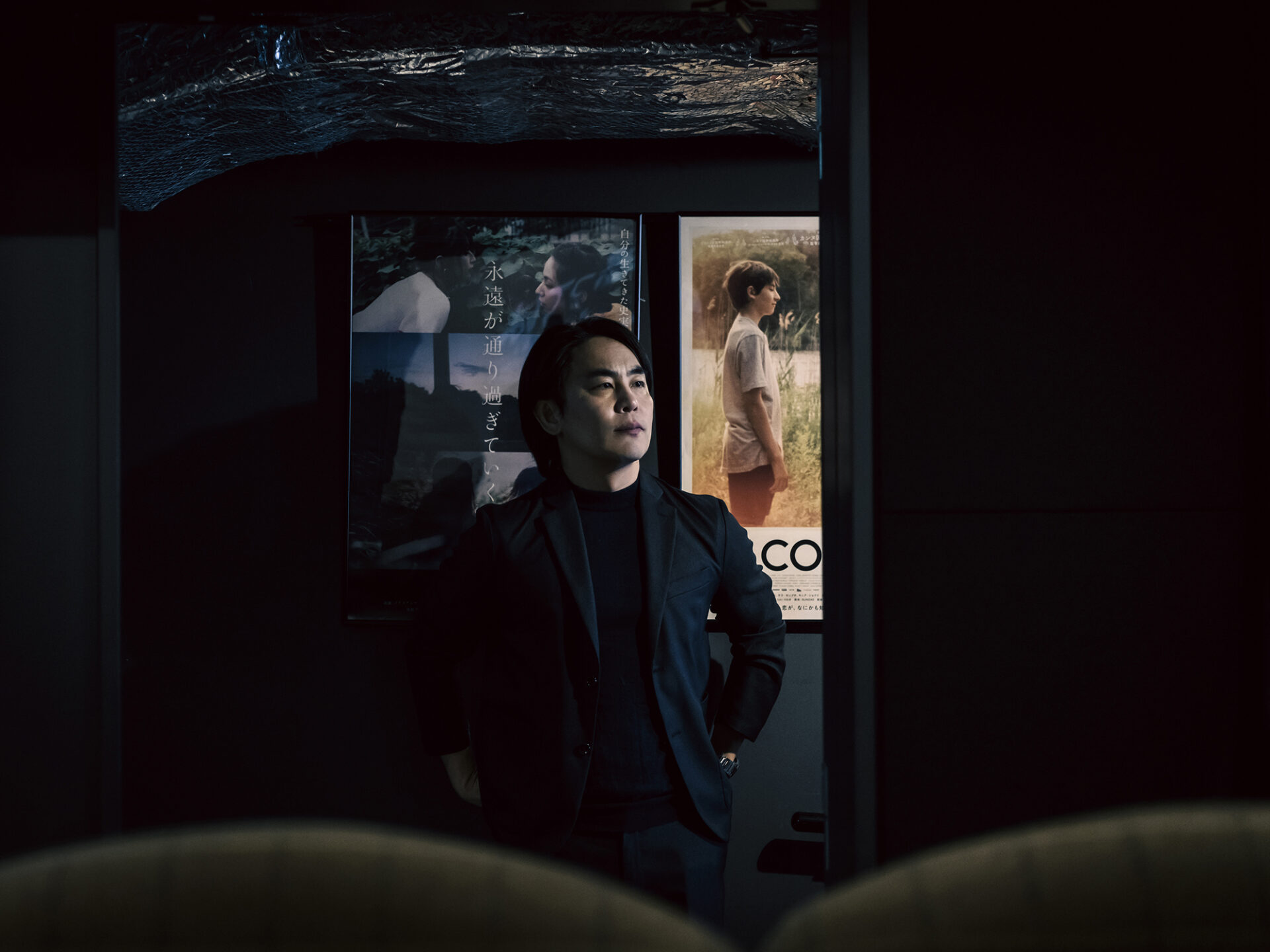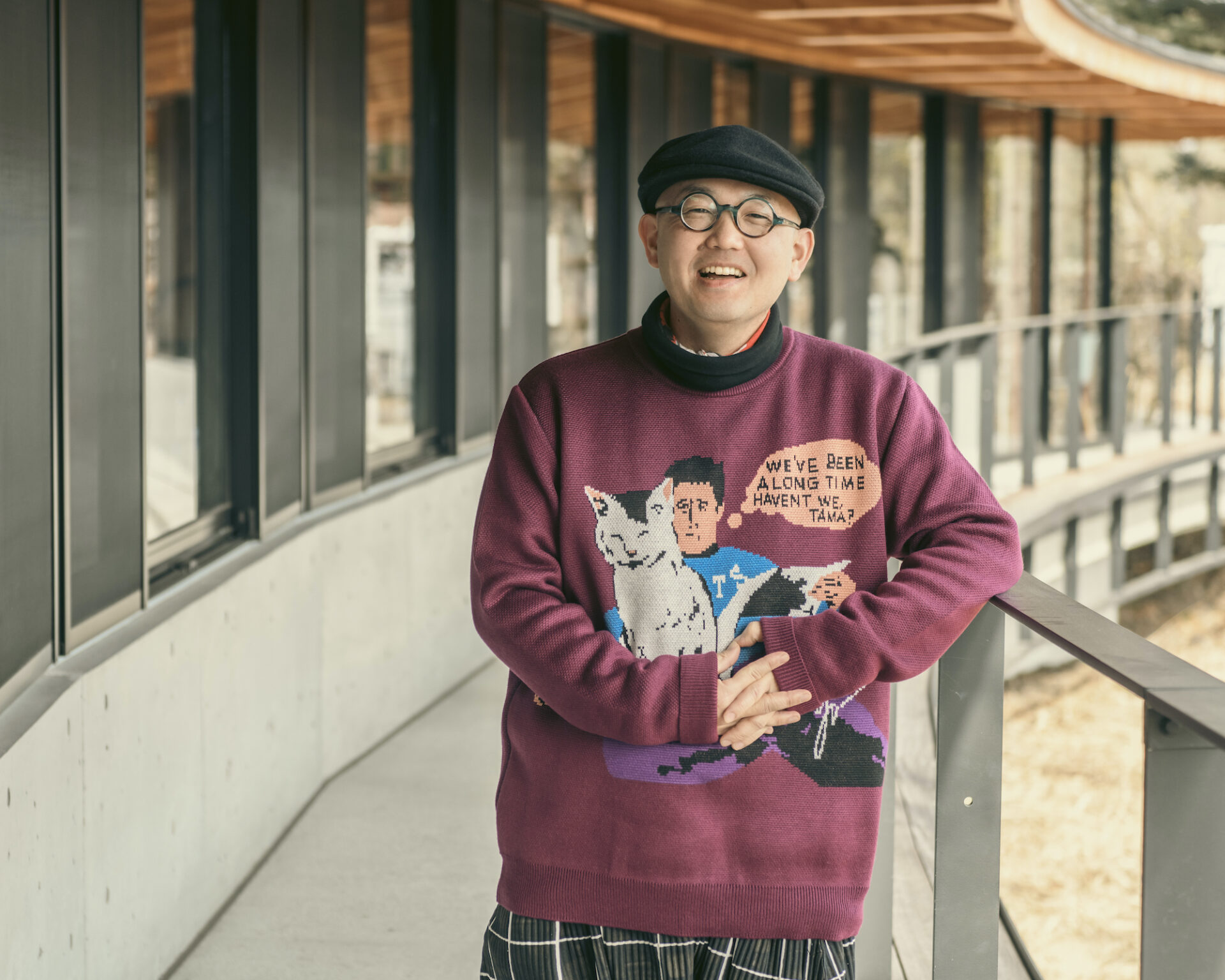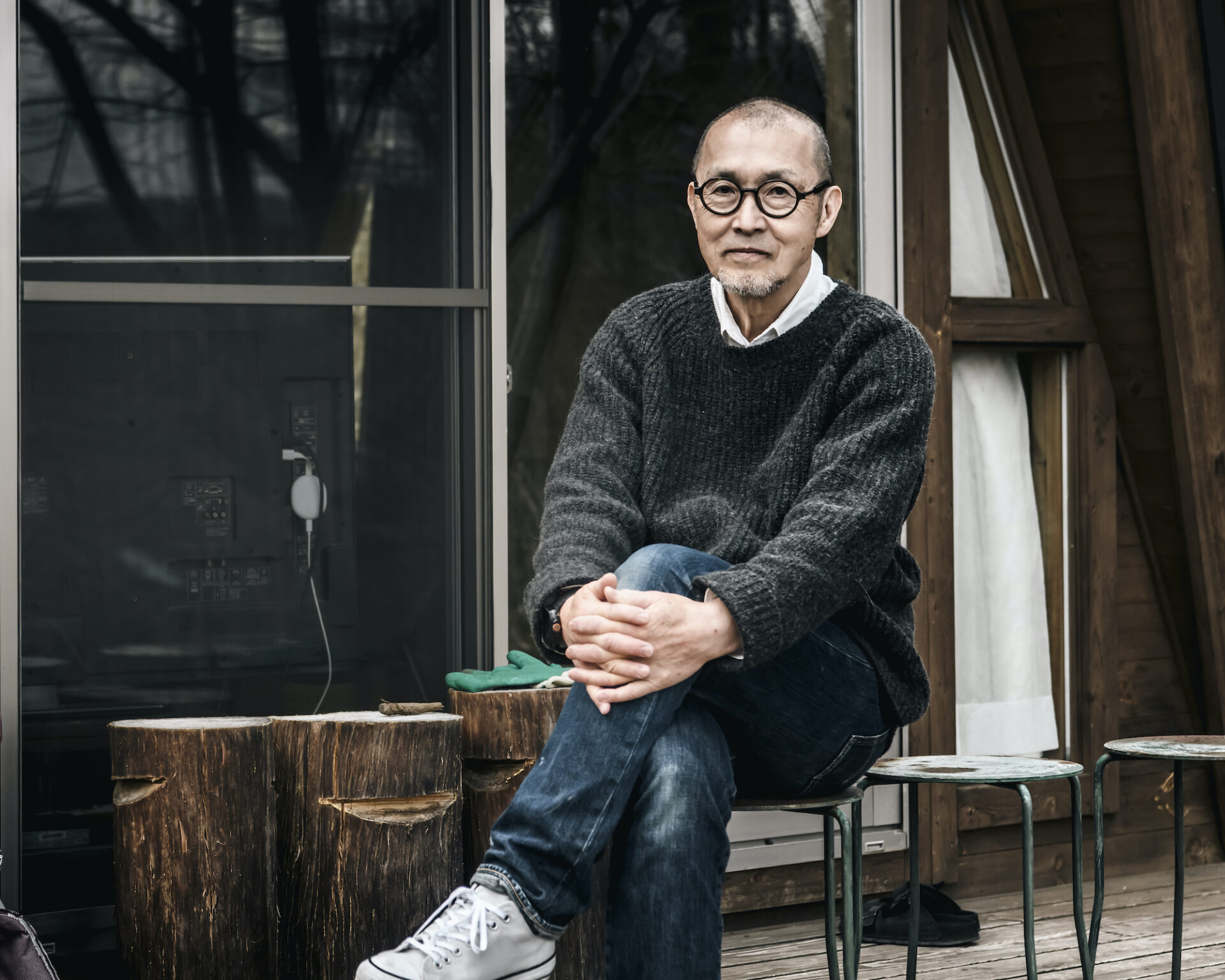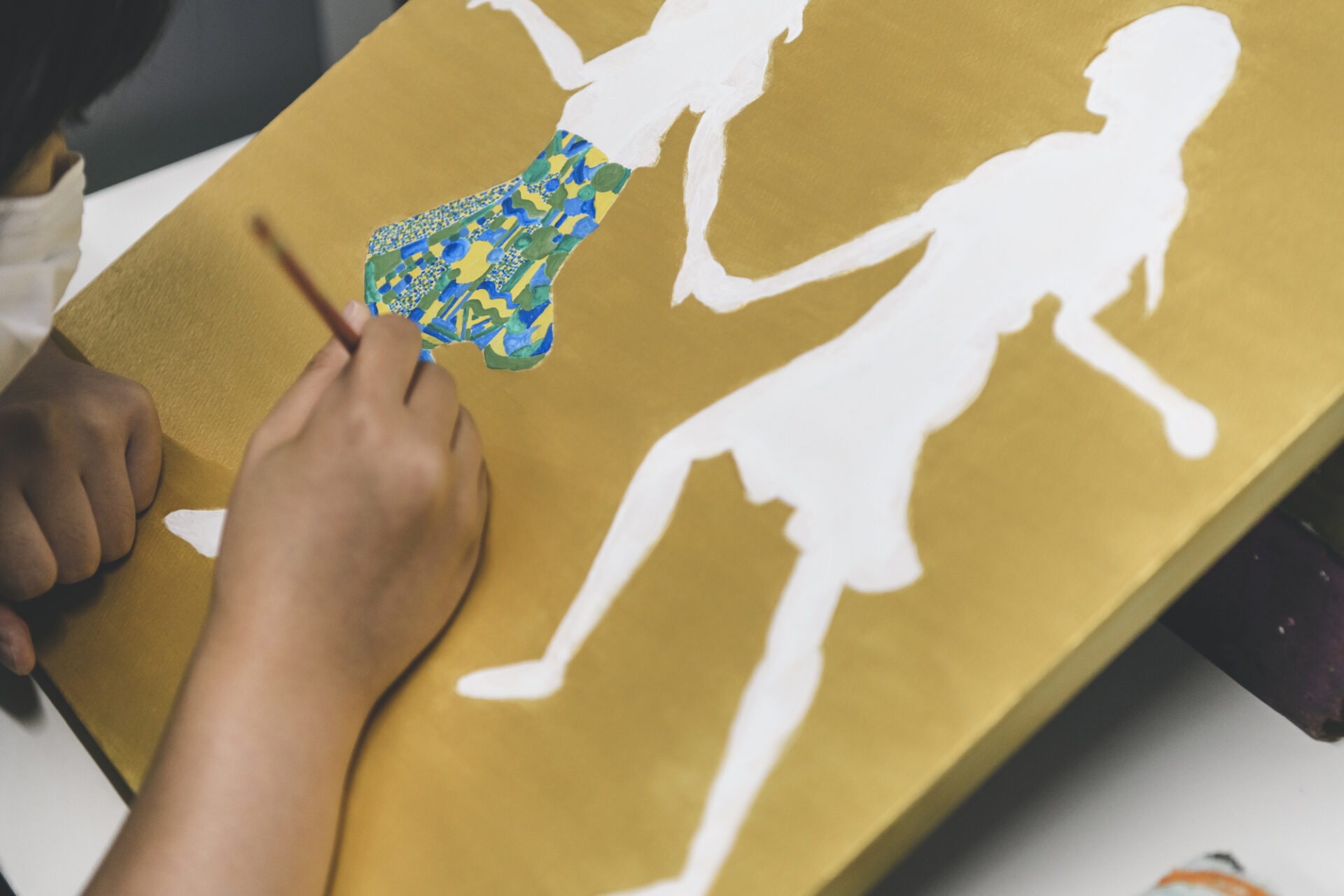
2025-09-25
Vol.21
Facility Director at PICFA (Disability Welfare Service Facility)
Hiroyuki Harada(part 1)
-
A Sensational Encounter
-
The Reason for Art
-
Disabilities as Characteristics, not Individuality
-
Creating a Society Where Parents of Children with Disabilities Can Pass Away with Peace of Mind
Located within Kiyama Kage Hospital in Kiyama Town, Saga, there is a unique facility that attracts visitors from around the world — PICFA, a disability welfare service facility. Here, people with intellectual and mental disabilities pursue creative expression — primarily painting — using brushes, colored pencils, tablets, and more. Overseeing them with a gentle gaze is PICFA’s facility director, Hiroyuki Harada, our guest today.
True to its name — a fusion of PICture and welFAre — PICFA’s mission is to promote both the autonomy of people with disabilities and greater social understanding. Its approach goes beyond the doubts and unease that often surround the frequently emphasized value of “respecting diversity” — and instead challenges us to reflect on its true meaning. Since their first meeting in 2017, OSAJI brand founder Masakazu Shigeta has built a close relationship with Harada. He visited the facility to hear about Harada’s philosophy and vision for PICFA.
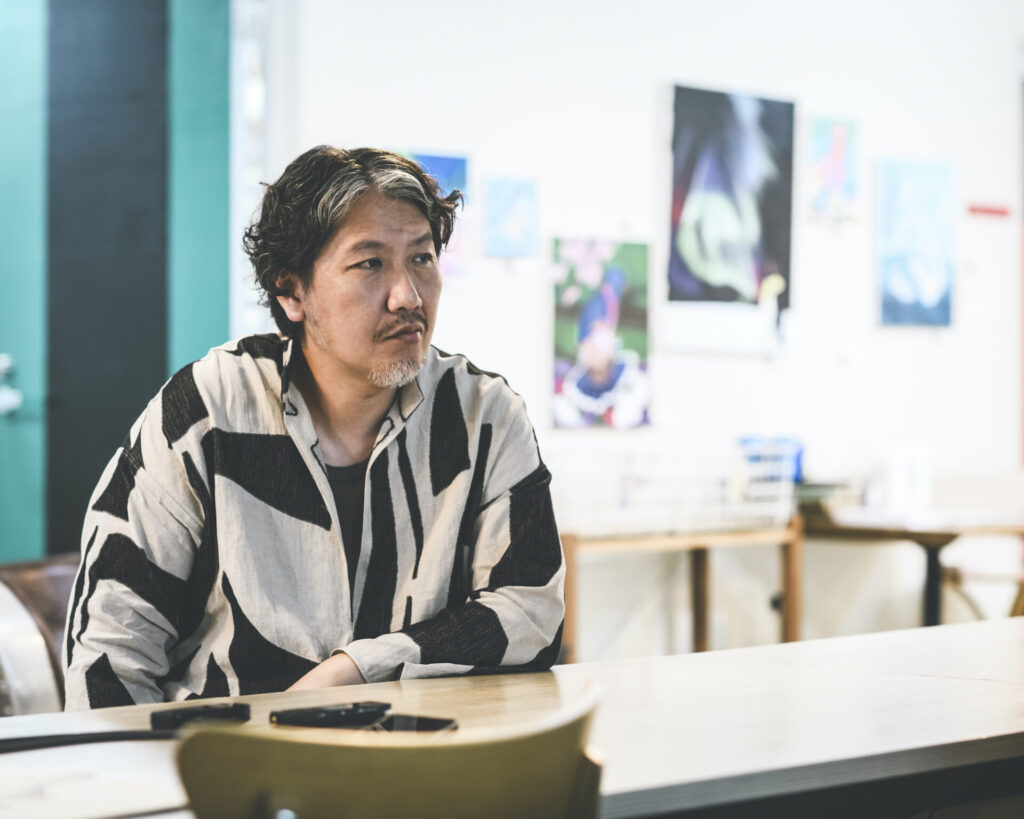
——Mr. Shigeta, you first met Mr. Harada when PICFA had just been founded.
Masakazu Shigeta: That’s right. PICFA and OSAJI are the same age — both born in 2017.
——What brought you together?
Shigeta: A project with a major retail group to develop private-brand cosmetics came up, and I happened to take charge of it. Taking into account the company’s vision and values, I proposed using artworks created by people with disabilities for the packaging design. The client responded positively, and I began searching for potential partners to make this happen with — and that’s how I discovered PICFA.
In the end, we went with another facility for the project at the time. While a collaboration with PICFA didn’t materialize, I had become very interested in what they were doing. Partly as an apology and partly out of genuine curiosity, I reached out to Mr. Harada and asked if I could come over. I first visited just a few months after PICFA had been founded.
Hiroyuki Harada: Our facilities were much more basic back then — maybe we had only about three tables. When he said, “I’d like to come to Saga for an apology,” I initially replied, “You don’t have to come all the way from Tokyo just to tell me that.” That kind of thing happens quite often in business situations. Nevertheless, he kept insisting that he would come anyway.
When he first reached out, he introduced himself, saying, “I’m Shigeta from Nitto Elechemic,” and I initially thought someone a bit intimidating was coming. Why would someone from an industrial company reach out to us? I was expecting a person in a suit with a serious atmosphere to come, but I was totally wrong — he was friendly and spoke in a gentle manner. Moreover, he told me that he works on producing cosmetics. What surprised me even more was when he said, “I’m actually glad that other companies haven’t reached out to you because we really want to work directly with PICFA.”
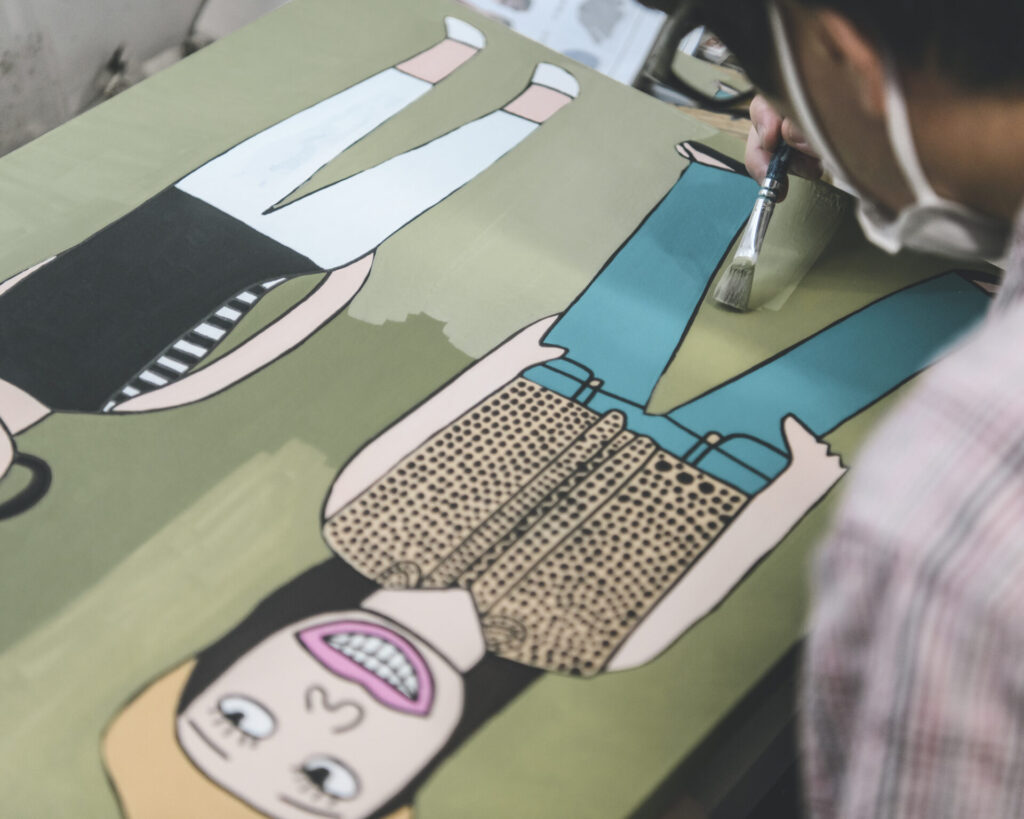
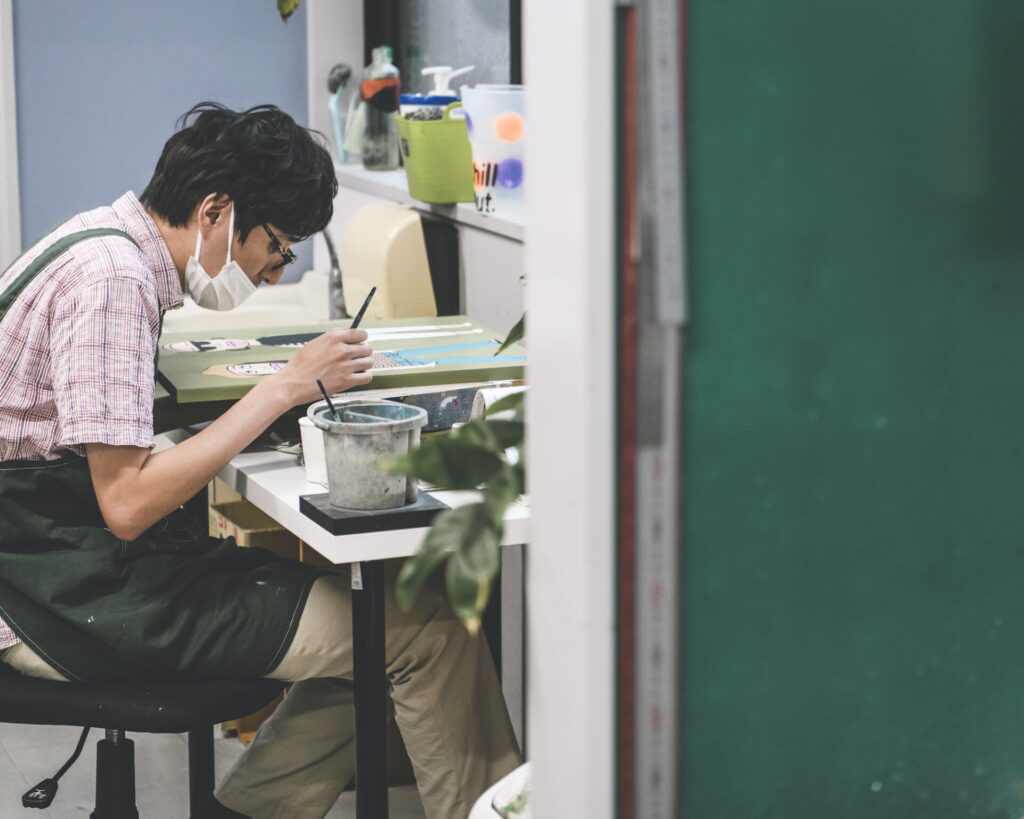
Shigeta: Looking back now, I think it was really a sensational encounter. After touring the facility, we drove around Hakata. He showed me murals that he and artists with disabilities worked on together during his “Atelier Bravo” days, before PICFA was founded. Through the conversations in the car, all the discomfort I had felt about welfare work and artworks created by people with disabilities completely disappeared.
——What kind of sense of discomfort did you have?
Shigeta: Well, two things really shocked me about Mr. Harada.
The first was a story from his Atelier Bravo days, when some young people would come at night to spray graffiti over the murals. When they saw Mr. Harada at the scene, they thought “Oh no!” and tried to run away. But Mr. Harada caught them and said, “Let’s have a battle together!” He even called over an older woman who had been there keeping watch to prevent graffiti, and tried to find a way for everyone from different generations to co-exist around art and the local community.
The second was about a story when a department store commissioned them for a window display. Mr. Harada asked the client, “Are we given this opportunity to use a prime location simply because our artworks are created by artists with disabilities?” He felt uncomfortable with the idea that, while there are countless artists whose artworks don’t sell, artists with disabilities are allowed to exhibit their works just because they have disabilities. He asked the client, “If possible, I’d like you to mix excellent works together, regardless of whether they are created by artists with disabilities or not.”
——He wants people with and without disabilities to co-exist without any barriers.
Shigeta: When PICFA held an exhibition in Tokyo, a younger brother of one of the PICFA members came to the venue and said, “I envy my big brother. I wish I had a disability, too.” He was a graphic designer, and I think he envied his brother for the opportunities he received because of his disability. I can understand that some people might feel that way.
Families who have members with disabilities have all kinds of complex feelings, and I can’t make light judgments about what’s right or wrong. But I do wonder if it’s really good for someone to have their artworks evaluated solely because they have disabilities? Is it truly enriching for society if artworks are commercialized and monetized just because they are created by artists with disabilities? I think I had always carried that sort of discomfort within me.
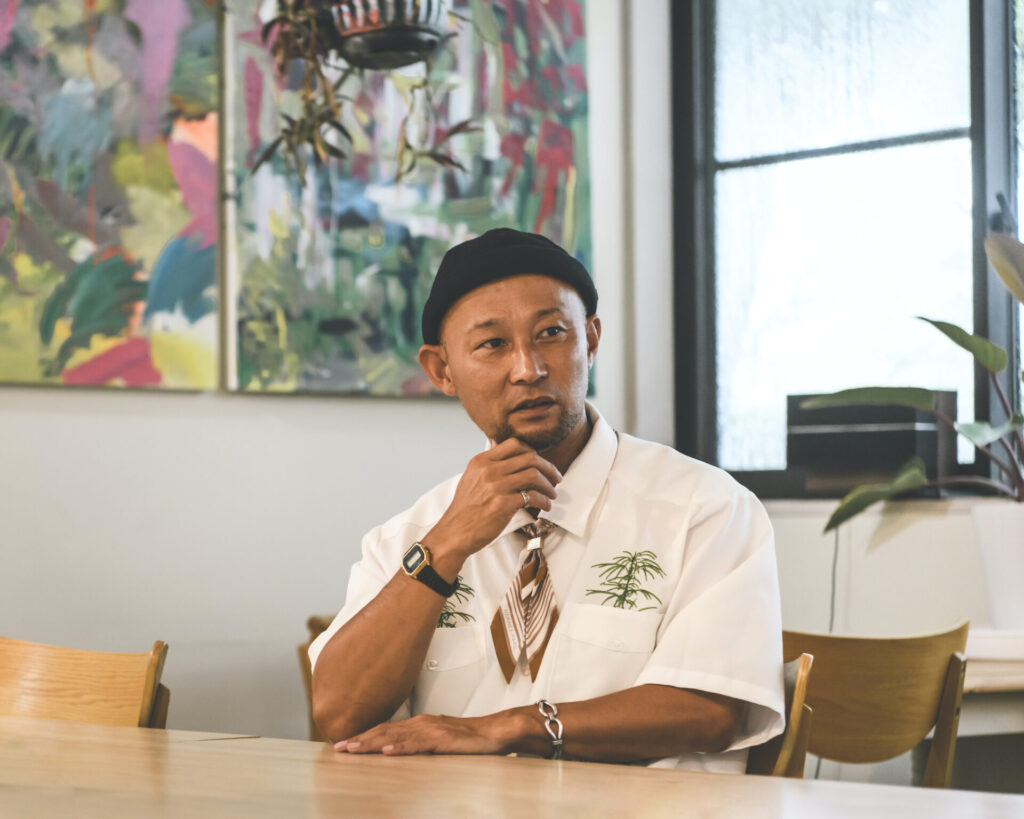
“When I realized that having disabilities or not has nothing to do with touching people’s hearts through art, I decided that I must continue this work.” (Harada)
——OSAJI has been collaborating with Neba Juku, a support facility for people with disabilities in Nagano, to develop and sell “Raw Soap” since 2017.
Shigeta: It’s been over 10 years since we started working with them. Some media coverage often frames this with a tone that we’re “supporting a disability facility,” but I don’t have that mindset at all — not even one bit.
First of all, we started with a vision of the soap we wanted to create. We approached various factories, but they all turned us down because the process would be too inefficient. We were wondering where we could find someone to make this, and that’s when Neba Juku reached out to us, saying, “We’d like to do some handwork, so let us take on this job”. We were looking for a partner who could produce soap by hand, and they had found a company that would commission that kind of job. There was a win-win relationship formed between OSAJI and Neba Juku, which had nothing to do with whether they were a disability support facility or not.
Businesses aimed at supporting people with disabilities can continue as long as you have economic leeway. But there’s no guarantee of whether you can maintain the same commitment when your company faces financial difficulties. Collaboration can’t last on one-sided support alone. Without a relationship where both parties trade their unique strengths, things don’t go well in today’s society, where diverse personalities are competing.
I dropped out of university and quit a job almost immediately after starting it. In that sense, I am a social misfit. But I also think it’s precisely because I’m that kind of person that I can share ideas and thoughts with others. I remember having conversations like this with Mr. Harada while we were driving around Hakata.
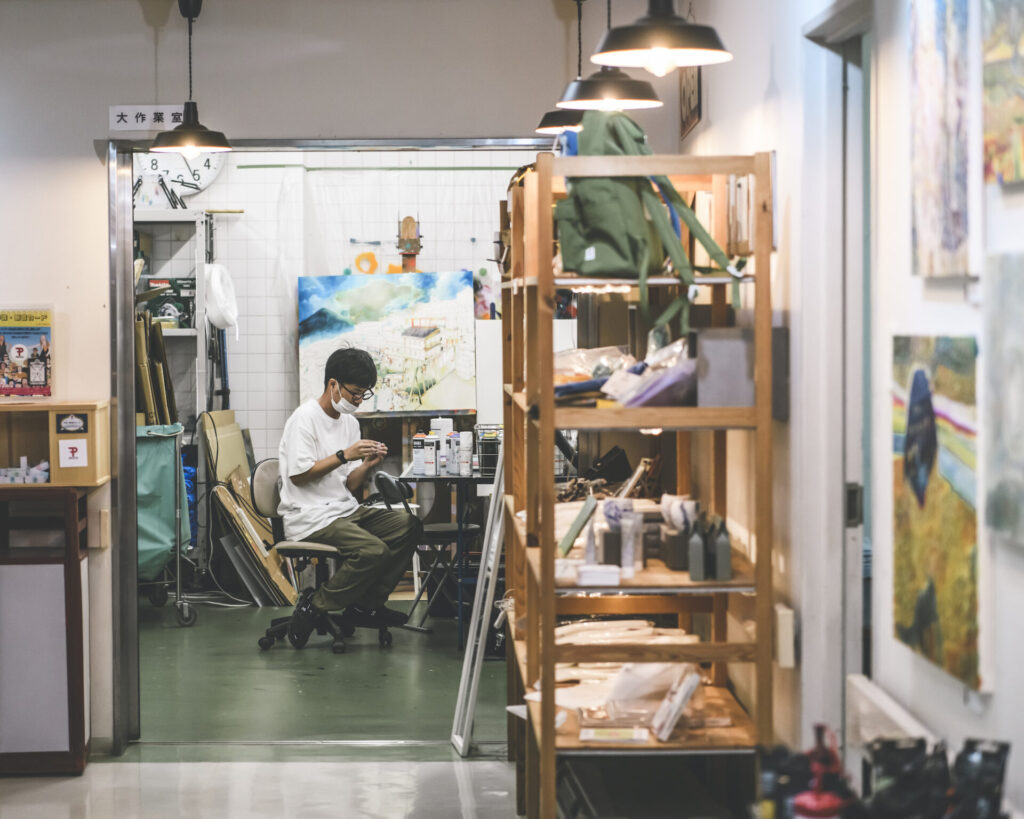
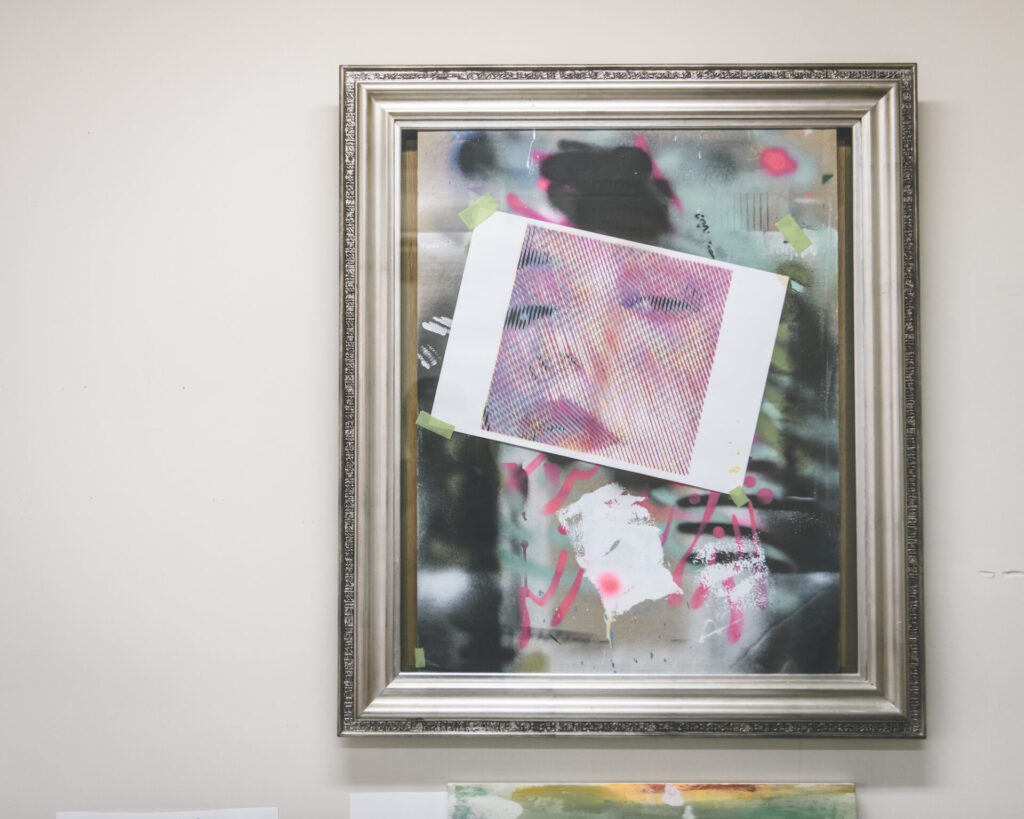
Harada: When I decided to establish a disability support facility in 2002 with the goal of “art as a business,” the category of art by artists with disabilities was quite vague at the time. There was no facility focusing on art as a business. I chose to focus on art because anyone can engage with it freely, regardless of the level of disability. Among the members of PICFA, some have no first joints on their fingers, while others have paralysis on one side of their bodies. When technical requirements are more demanding, there are inevitably more things we can’t handle. While certain distinctions are necessary, I felt it was wrong to separate what they can and can’t do based on ability or IQ. If you have something you really love, you should pursue it wholeheartedly and share what you’ve created with society. Things that people can do naturally don’t need training. That’s why I focused on art.
However, since I had only worked in welfare up to that point, I knew nothing about art. How could art become a viable business? I didn’t even know how to add additional value to what we’ve created. So, I kept visiting the ateliers of various artists to learn about the materials they used and how they exhibited their works.
Actually, I could have gotten art supplies from a 100-yen shop. However, I wanted to provide members with materials with solid evidence behind them, like those used by professional artists. Paints that would last 100 years, canvases that would last 100 years — I wanted to equip them with proper tools for their work.
——So, you were able to take bold action because you knew so little about art.
Harada: I had no idea how to present or promote the artworks — things like whether we needed to categorize the exhibition by type or the artworks. When we exhibited artworks created by artists with and without disabilities together, a person furiously yelled at us, saying, “Are you trying to become like people without disabilities!?” At first, I had no idea what the person was talking about, but every time we heard criticism like that, I thought to myself many times, “Maybe I shouldn’t continue this any further?”
But that’s when this old lady just appeared out of nowhere and told children with intellectual disabilities, “You guys draw such beautiful lines.” She continued, “Most people can’t draw lines like these. Do you understand that? I’m so moved that I wanna treat you to lunch,” and she brought so much pizza that we couldn’t finish it all. I guess she might have felt some pity for people with disabilities. But more than that, I believe she was genuinely moved by the lines the children had drawn. I realized that having disabilities or not has nothing to do with touching people’s hearts through art, and I decided that I must continue this work.
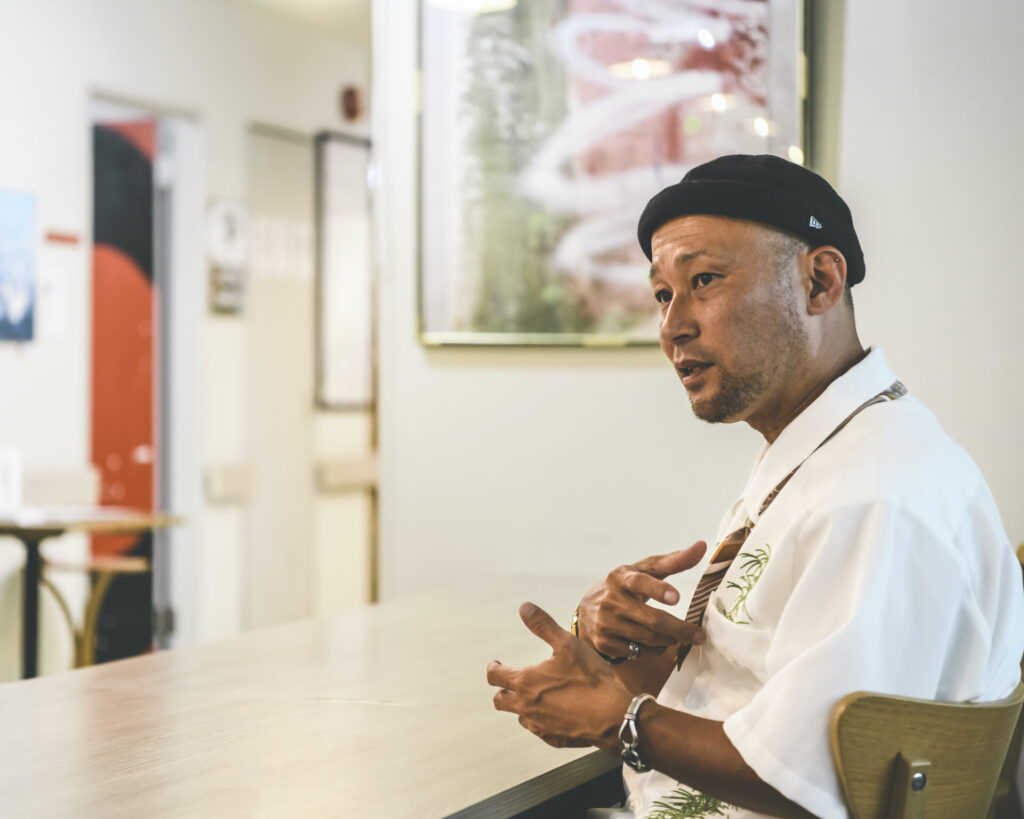
“In Japan, there still aren’t many people who can truly understand the characteristics and individuality of people with disabilities while offering genuine support.” (Harada)
Harada: After meeting Mr. Shigeta, PICFA started receiving design work from OSAJI and department stores. Mr. Shigeta is crazy — and that’s my highest compliment, by the way — he doesn’t hesitate to give honest feedback. When we collaborate with companies, some people compromise with good intentions by saying, “Actually, I want to revise this part a bit, but they put so much effort into drawing it, so let’s go with this for now.” If they had commissioned artists or illustrators without disabilities, they would normally ask for revisions until they were satisfied, but they probably hesitate to do that with artists with disabilities.
I understand this as a form of consideration, but in the case of Mr. Shigeta, if something doesn’t match his vision, he’ll tell us straightforwardly. When I relay this feedback to the members, they actually get excited — some even say “we can draw more!”
They get the straightforward response much less than you imagine. People inevitably choose their words carefully, wrapping up everything in euphemisms. While I appreciate this form of consideration, I want people to see them as individuals. Since we’re selling these artworks as commercial products, creating isn’t the end goal. They need to sell, and if they don’t sell, there won’t be a next opportunity. As long as we’re selling them as products, we can’t afford to compromise. The collaboration with OSAJI was probably the first time that both the client and we could work together with complete satisfaction and clarity until the end.
Shigeta: The way you speak to the members is also direct. You don’t hesitate to tell them off when necessary.
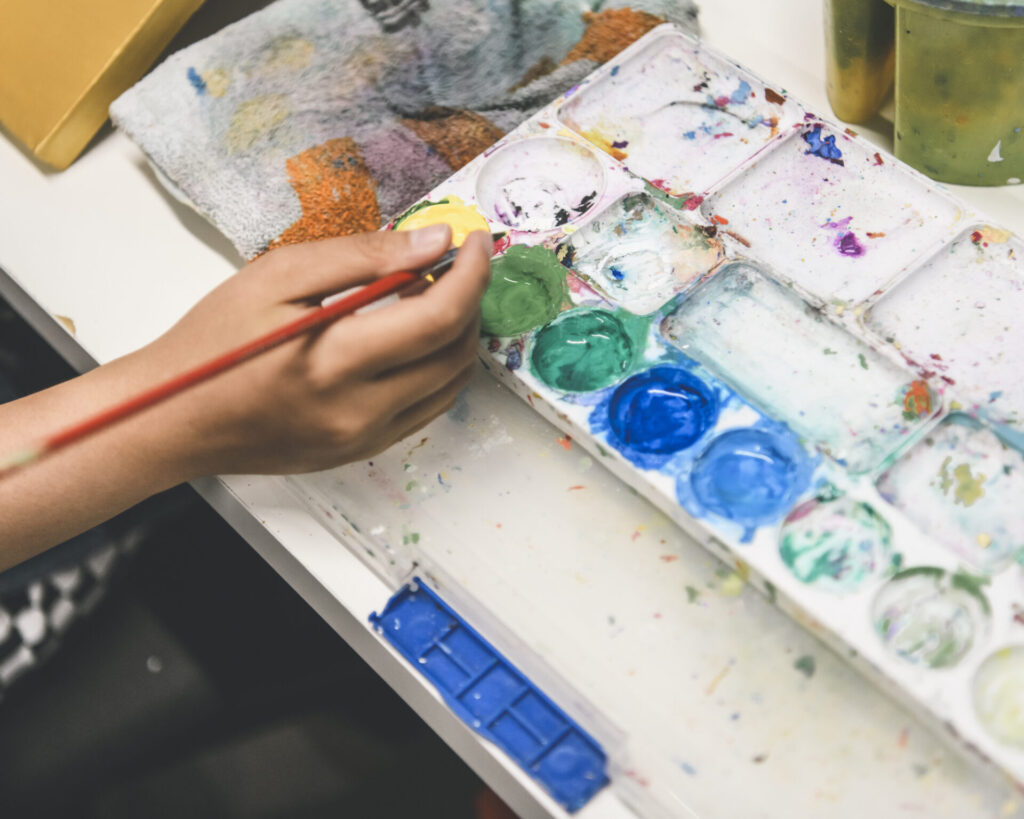
Harada: Regardless of the type and level of their disabilities, I always make sure to clearly communicate what’s wrong to those who misbehave. There are many cases where people give up telling them because of their severe disabilities. They think, “The world they are in is special, so there’s no need to push them.” But in reality, these people with disabilities live in the same everyday world we do. In Japanese society, where social understanding of welfare can hardly be said to have progressed, there still aren’t many people who can truly understand the characteristics and individuality of people with disabilities while offering genuine support.
——From your choice of words, it’s clear to me that Mr. Harada sees disabilities as characteristics, not individuality. You believe that individuality develops as an extension of those characteristics. However, most people out there see disabilities as individuality itself, and I think there’s a gap in understanding between people with disabilities and society as a whole.
Harada: Seeing disabilities as individuality is entirely wrong. They are characteristics, pure and simple. Autism, Down syndrome, and mental disabilities are among them. Everyone, regardless of whether they have disabilities or not, has characteristics. If you can see each person’s individuality as an extension of their characteristics, you wouldn’t hesitate to go out for drinks with them.
You can interact with them like anyone else — “That guy can really hold his drink,” or “She loves to sing.” While we make our living through art, we are not trying to showcase how amazing art is. Art is just a means to connect with various people and brands. It is also a way to increase the number of friends of members. We are not trying to increase the number of people who understand us or supporters, but we want to increase the number of people who think, “I think we’d get along well,” or “I’d like to grab a drink with them.” The people who are happiest about this are the parents — especially their mothers.
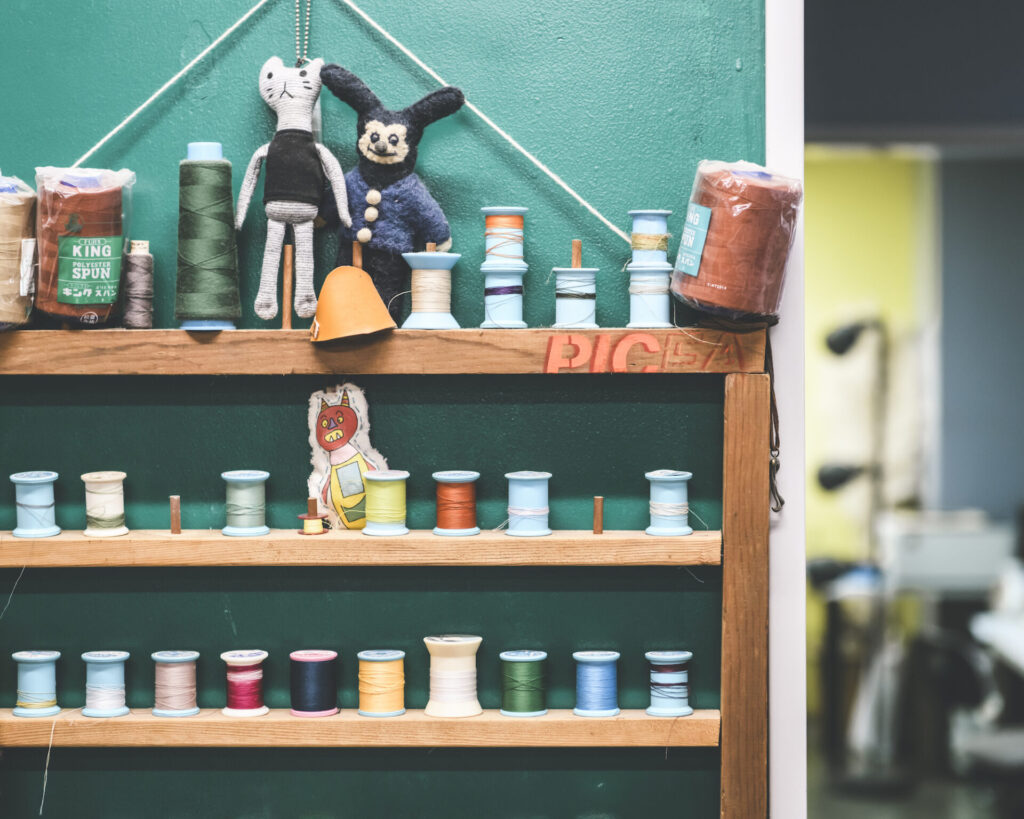
“The atmosphere and warmth of PICFA are a product of Mr. Harada’s approach to members and communication with the staff. It’s also an excellent example of how communication within companies should be.” (Shigeta)
——Since the 2000s, welfare-themed exhibitions at public art museums in Japan have been gathering large crowds. Recently, there’s also been an increase in the number of companies trying to support artists with disabilities through business. What are your thoughts on this current situation, Mr. Harada?
Harada: When I was studying welfare at university 25 years ago, I never could have imagined that such an era would arrive. The continuous entry of companies and the government’s active support for promoting arts and culture among people with disabilities — this represents a significant transformation in welfare. According to the latest statistics, there are currently 11.64 million people with disabilities in Japan, representing 9.3% of the whole population. In the sense that these people now have more options, this is certainly favorable.
On the other hand, as more companies enter this field and commissions come in and artworks sell well with no specific effort, I’m afraid the number of people working directly in welfare is decreasing. Why are artistic activities being practiced in welfare settings? What does it mean to engage with people with disabilities to share value with them?
If people stop thinking about these fundamental questions simply because they’re distracted by the growth of business, I find this somewhat concerning.
Shigeta: As a friend, let me share something that I think many people don’t know about. In the first two or three years after we met, Mr. Harada was really wavering between whether to pursue art or welfare. Rather than just wondering, he was truly lost. If he had continued on that path, he probably would have ended up caught between two stools. But at a certain point, he made a clear decision to focus on welfare. Looking back now, I think that was the major turning point for PICFA.
While artworks created by people with disabilities — often called Art Brut or outsider art — are receiving more attention than ever, PICFA has maintained its grounded activities because they have never wavered from their core mission. The question isn’t about whether they create good artworks or not, but rather how to make a society where the parents of people with disabilities can pass away with peace of mind. I believe their consistent pursuit of this theme has been the key to their success.
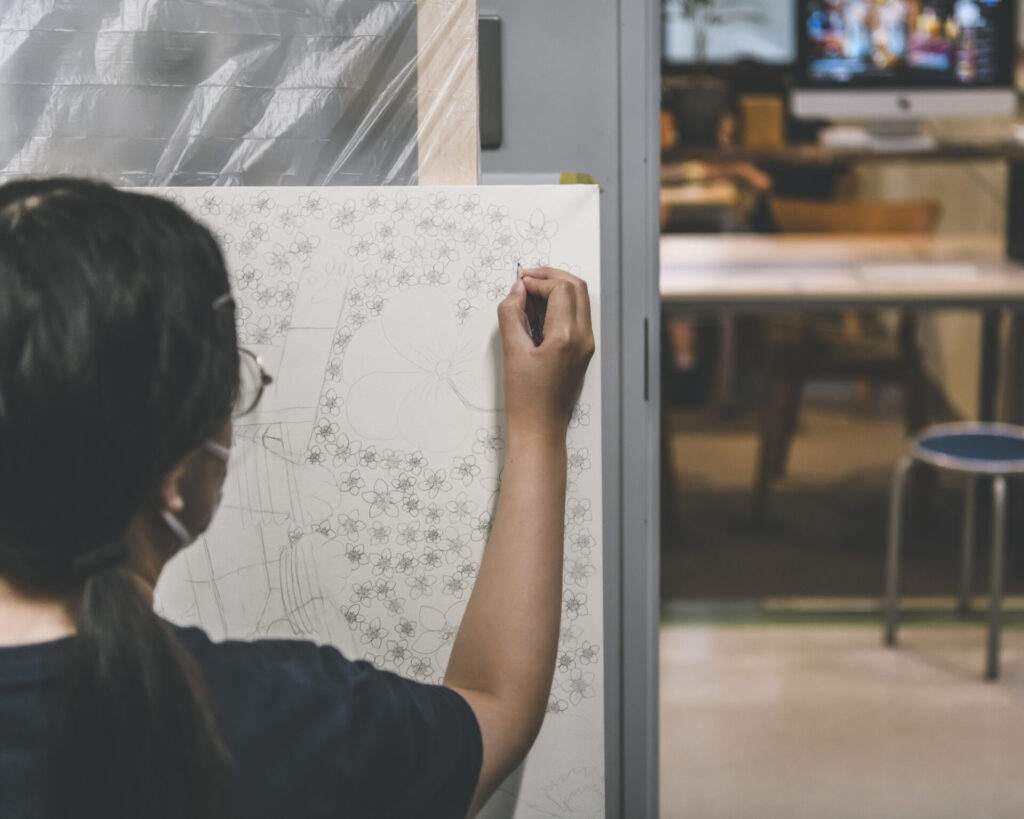
——What ultimately made you decide to focus on welfare after all that wavering?
Harada: I initially believed that we had to work equally on art and welfare. When art takes center stage, people tend to see it as something unconventional — while when welfare takes over, it can lose its impact. I was trying to avoid both extremes by maintaining the balance. But the question was when to break free from that framework. There’s always this invisible pressure and unspoken sense of how welfare should be.
After meeting Mr. Shigeta, he introduced me to many people with unique perspectives from different industries whenever I went up to Tokyo. When I shared my situation with them, they would casually say, “Why don’t you just go all in?” or “How come we can’t do that with welfare?” Unlike Mr. Shigeta, I’m someone who studied welfare at university and lived a fairly conventional life (laughs). But that’s why I always had this preconceived notion, “welfare should be like this,” and I was always imposing limitations on myself, thinking, “It wouldn’t be welfare anymore if we go any further.”
But when I thought, “If I’m going to worry this much, I might as well just throw these preconceptions,” I decided to remove these self-imposed limitations about welfare — and the result turned out to be surprisingly ordinary. Nobody complained when people with and without disabilities shared drinks together. Instead, everyone seemed to be enjoying themselves. Seeing this, I thought, “Well then, let’s hold a snack bar session together”, and now we have a temporary snack bar in our facility once or twice a year.
I realized that if you don’t have a clear answer, you might as well push the boundaries until your action actually gets someone mad at you. I think becoming able to adopt that mindset was the turning point when I fully started focusing on welfare. Looking back now, I regret that I wasn’t able to do ordinary things in an ordinary way back then.
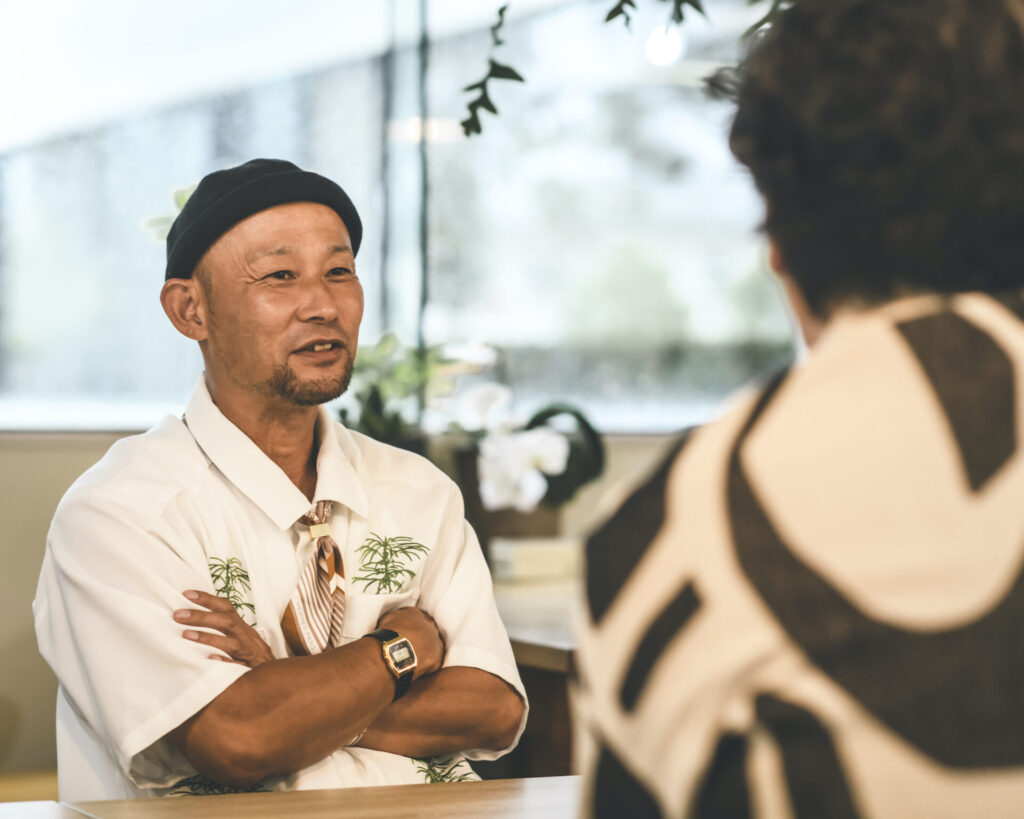
Shigeta: Listening to what you just mentioned, I thought it could be applied to corporate HR and organizational theory. With all these harassment-related terms being widespread, addressing individual characteristics is becoming increasingly taboo within companies. Even people without disabilities can’t accept the characteristics of each other. That trend creates pressure that makes people hesitate to even say something like “Let’s go for a drink together.” In this atmosphere of “Can I say this or not?” people are unsure of their own tact and end up choosing to play it safe by simply “saying nothing”, and we fall into a vicious cycle.
The atmosphere and warmth of PICFA are a product of Mr. Harada’s approach to members and communication with the staff. It’s also an excellent example of how communication within companies should be. That’s why I want my company’s staff to interact with PICFA in various ways, and I always bring business leaders here who I think would want to become friends with Mr. Harada. I believe you can find the ideal form of human communication through PICFA.
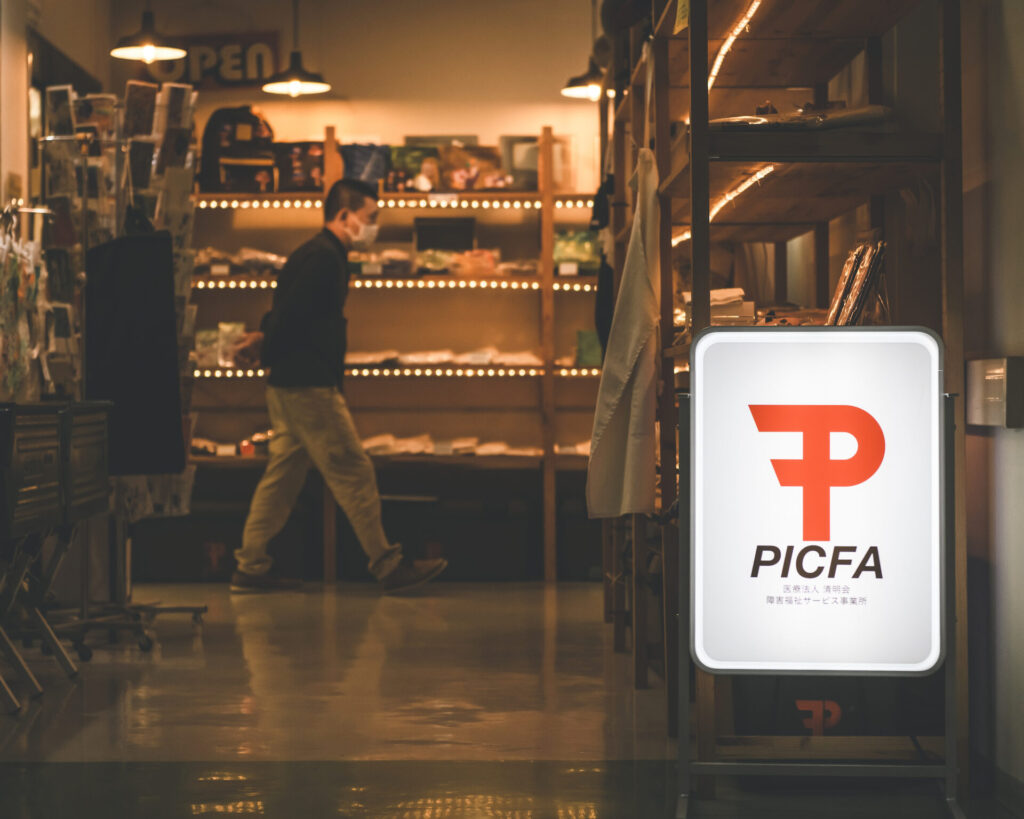
(to be continued in the second half)
Notes:
Atelier Bravo
An artist group founded by Harada in 2002, aiming for the social participation of people with disabilities through art. Organized by JOY Club, a disability welfare service facility, the group is currently active with ten members based in Hakata, Fukuoka. At ART FAIR ASIA FUKUOKA 2025, held in late September, they were the only welfare facility to participate as an exhibitor, and their artworks have also gained international recognition. Their representative works include wall art in Fukuoka city’s streets, using walls as canvases for their creative expression. This wall-based creative approach has also been implemented in New York.
Neba Juku
A welfare service facility founded in Saku, Nagano, in 1978, aiming to achieve economic independence for people with disabilities. To help them achieve financial independence with a stable income, they started producing soaps using waste cooking oil in 1983. Currently, in addition to developing and producing their own brand products, they also handle OEM production. OSAJI’s “Raw Soap”, a collaboration product between the two companies that has been a long-running hit since its release in 2017, took two years to develop.
Profile
-
Hiroyuki Harada
Born in Fukuoka in 1974. With an older brother who had an intellectual disability, he grew up observing firsthand the struggles and challenges of children with disabilities and their families. Drawing from these experiences and motivated by a desire to “change the concept of welfare,” he chose to study at Nihon Fukushi University, where he began his formal education in welfare. After graduating in 2000, he participated in establishing JOY Club, a disability welfare service facility that centered its work on music and art, serving as deputy facility director. In 2002, he launched “Atelier Bravo” as the art section and handled event planning and external relations. In 2017, aiming to further strengthen the connection between welfare and society through creative activities, he founded PICFA within Kiyama Kage Hospital and has served as the facility director since then. From 2021, he has served as the advisor for Kyoto City’s employment promotion advisory service for people with disabilities. He also has a record of winning the national championship in soft tennis in both junior high school and high school.
-
Masakazu Shigeta
After working as an engineer in the music industry, Shigeta began his career as a cosmetics developer in 2001. From 2004, he worked on various cosmetics brands in the healthcare business of Nitto Denka Kogyo Co., Ltd., a metal surface treatment company founded by his great-grandfather. In 2017, he founded “OSAJI,” a skincare lifestyle brand, and became its brand director. In 2021, as a new store of “OSAJI,” he produced “kako,” a specialized shop for home fragrances and perfume in Kuramae, Tokyo. In the following year, he opened a combined shop of “OSAJI,” “kako,” and a restaurant, “enso,” in Kamakura, Kanagawa. In 2023, utilizing the technical skill of Nitto Denka Kogyo, he launched a pottery brand, “HEGE,” and in October of the same year, he became CEO of OSAJI Inc. He also has published books on beauty and held cooking classes and events focusing on food, which is the origin of beauty. He released a collaborative album with F.I.B JOURNAL called “Gensho hyphenated” in November 2024 and has been expanding the range of activities.
Publications
Taberu Biyou (Eating for Beauty) (SHUFU TO SEIKATSU SHA, 2024)
42-Sai ni Nattara Yameru Biyou, Hajimeru Biyou (Beauty cares to quit and start when you turn 42) (Takarajimasha, 2022)
Information
PICFA
PICFA is Japan’s first Type B employment support facility for people with disabilities located within Kiyama Kage Hospital in Kiyama Town, Saga, part of the Seimeikai Medical Corporation, which has operated for 350 years. With twenty members with intellectual disabilities, autism, and Down syndrome, the facility offers support for them to achieve independent living through creative activities such as art and design. The name PICFA is a coined word from PICture and welFAre, reflecting their commitment to pursuing both creative activities and welfare support. Their artworks and collaboration items are available on their website.
https://picfa-shop.jp
-
Photographs:Eisuke Komatsubara
-
Text:Masahiro Kamijo
NEWS LETTER
理想論 最新記事の
更新情報をお届けします
ご登録はこちら
ご登録はこちら
メールアドレス
ご登録ありがとうございます。
ご登録確認メールをお送りいたします。
